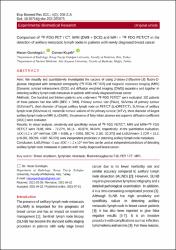| dc.contributor.author | Gündoğdu, Hasan | |
| dc.contributor.author | Kupik, Osman | |
| dc.date.accessioned | 2022-06-17T11:46:03Z | |
| dc.date.available | 2022-06-17T11:46:03Z | |
| dc.date.issued | 2021 | en_US |
| dc.identifier.citation | GUNDOGDU Hasan,KUPIK Osman Comparison of 18F FDG PET / CT, MRI (DWI + DCE) and MRI + 18F FDG PET/CT in the detection of axillary metastatic lymph nodes in patients with newly diagnosed breast cancer. Experimental Biomedical Research, vol.4, no.3, 2021, ss.206 - 215. Doi: 10.30714/j-ebr.2021370075 | en_US |
| dc.identifier.issn | 2618-6454 / 2618-6454 | |
| dc.identifier.uri | https://doi.org/10.30714/j-ebr.2021370075 | |
| dc.identifier.uri | https://hdl.handle.net/20.500.12809/10038 | |
| dc.description.abstract | Aim: We visually and quantitatively investigated the success of using 2-deoxy-2-[fluorine-18] fluoro-D-glucose integrated with computed tomography (18F-FDG PET/CT) and magnetic resonance imaging (MRI) [Dynamic contrast enhancement (DCE) and diffusion weighted imaging (DWI)] separately and together in detecting axillary lymph node metastasis in patients with newly diagnosed breast cancer. Methods: One hundred and thirteen patients who underwent 18F FDG PET/CT were evaluated, 102 patients of these patients had also MRI (DEC + DWI). Primary tumour size (Tsize), SUVmax of primary tumour (SUVmaxT), short diameter of largest axillary lymph node on PET/CT (LnDPET/CT), SUVmax of axillary lymph node (SUVmaxLn), metabolic tumour volume of the primary tumour (MTV), short diameter of largest axillary lymph node on MRI (LnDMRI), the presence of fatty hilum absence and apparent diffusion coefficient (ADC) were evaluated. Results: In visual analysis, sensitivity and specificity values of 18F FDG PET/CT, MRI and MRI+18F FDG PET/CT were 78.85, 94% – 72.27%, 96.15 – 83.87%, 98.04%, respectively. In the quantitative evaluation, ADC≤1.2 x 10-3 mm2/sec (OR = 6.665, p = 0.001, 95CI%: 2.181–20.370) and LnSUVmax> 2 (OR = 15.2, p<0.001, 95CI%: 4.587–50.376) were independent predictors in detecting axillary lymph node metastasis. Conclusion: LnSUVmax >2 and ADC ≤ 1.2 x 10-3 mm2/sec can be used as independent predictors of detecting axillary lymph node metastasis in patients with newly diagnosed breast cancer. | en_US |
| dc.item-language.iso | eng | en_US |
| dc.publisher | Prof. Dr. Hayrettin Ozturk | en_US |
| dc.relation.isversionof | 10.30714/j-ebr.2021370075 | en_US |
| dc.item-rights | info:eu-repo/semantics/openAccess | en_US |
| dc.subject | Breast neoplasms | en_US |
| dc.subject | lymphatic metastasis | en_US |
| dc.subject | Fluorodeoxyglucose F18 | en_US |
| dc.subject | PET / CT, MRI | en_US |
| dc.title | Comparison of 18F FDG PET / CT, MRI (DWI + DCE) and MRI + 18F FDG PET/CT in the detection of axillary metastatic lymph nodes in patients with newly diagnosed breast cancer | en_US |
| dc.item-type | article | en_US |
| dc.contributor.department | MÜ, Tıp Fakültesi, Eğitim ve Araştırma Hastanesiü | en_US |
| dc.contributor.authorID | 0000-0001-9473-7940 | en_US |
| dc.contributor.institutionauthor | Kupik, Osman | |
| dc.identifier.volume | 4 | en_US |
| dc.identifier.issue | 3 | en_US |
| dc.identifier.startpage | 206 | en_US |
| dc.identifier.endpage | 215 | en_US |
| dc.relation.journal | Experimental Biomedical Research | en_US |
| dc.relation.publicationcategory | Makale - Uluslararası Hakemli Dergi - Kurum Öğretim Elemanı | en_US |


















